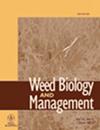Optimization of the year-round mowing schedule of a robotic lawnmower in a Japanese pear orchard
IF 1.5
4区 农林科学
Q3 AGRONOMY
引用次数: 0
Abstract
Commercial robotic lawnmowers have recently gained popularity in orchards. However, more widespread adoption of this technology in orchards requires optimization of the weed cutting height and cutting frequency. To determine the optimum weed cutting height, we tested a robotic lawnmower (Automower 430X, Husqvarna, Sweden) in a Japanese pear orchard at Ibaraki University, Ami, Japan. The mower was operated on short (weed height = 175 ± 42 mm (±SD), medium-sized (weed height = 286 ± 87 mm) and tall weeds (weed height = 404 ± 118 mm). To determine the optimum cutting height and frequency, we used a weed growth model and data from photogrammetry, weed mechanical properties, and field performance. Our analysis indicates that the mower should be operated when the height of the weed reaches 20 cm. To maintain weed height at <20 cm, the mower, on average, should be operated 10 h week−1 between April 5 and October 13. We believe that the proposed mowing schedule would significantly help the mower tackle field challenges in the orchard.日本梨园机器人割草机全年割草计划的优化
商用机器人割草机最近在果园里很受欢迎。然而,在果园中更广泛地采用该技术需要优化除草高度和修剪频率。为了确定最佳除草高度,我们在日本亚米市茨城大学的一个梨园里测试了一台机器人割草机(Automower 430X, Husqvarna,瑞典)。剪短杂草(杂草高度= 175±42 mm(±SD))、中等杂草(杂草高度= 286±87 mm)和高杂草(杂草高度= 404±118 mm)。为了确定最佳的切割高度和频率,我们使用了杂草生长模型和来自摄影测量、杂草力学特性和田间表现的数据。我们的分析表明,割草机应在杂草高度达到20 cm时操作。为使杂草高度保持在20厘米,在4月5日至10月13日期间,割草机应平均每周操作10小时。我们相信,拟议的割草时间表将大大帮助割草机解决果园的田间挑战。
本文章由计算机程序翻译,如有差异,请以英文原文为准。
求助全文
约1分钟内获得全文
求助全文
来源期刊

Weed Biology and Management
农林科学-农艺学
CiteScore
2.70
自引率
0.00%
发文量
13
审稿时长
>36 weeks
期刊介绍:
Weed Biology and Management is an international journal, published four times per year. The journal accepts contributions in the form of original research and review articles in all aspects of weed science. Contributions from weed scientists in the Asia–Pacific region are particularly welcomed.
The content of the contributions may relate to weed taxonomy, ecology and physiology, weed management and control methodologies, herbicide behaviors in plants, soils and environment, utilization of weeds and other aspects of weed science. All contributions must be of sufficient quality to extend our knowledge in weed science.
 求助内容:
求助内容: 应助结果提醒方式:
应助结果提醒方式:


